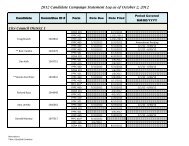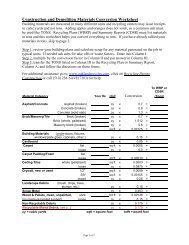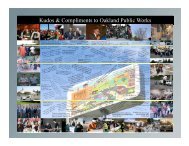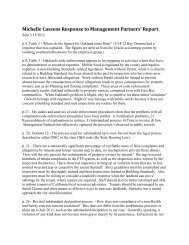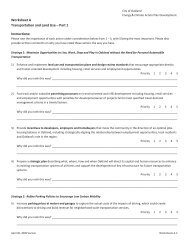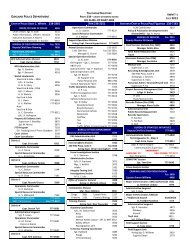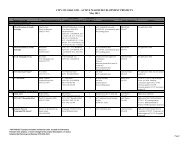Intelligent Transportation Systems - City of Oakland
Intelligent Transportation Systems - City of Oakland
Intelligent Transportation Systems - City of Oakland
Create successful ePaper yourself
Turn your PDF publications into a flip-book with our unique Google optimized e-Paper software.
Table 6.1 – Bandwidth Comparison<br />
D L V L D L &V L D L &2 V L D H &V H D H &2 V H D H &4 V H<br />
CDPD X<br />
POTS X – – – – – –<br />
ISDN X X X – – – –<br />
DSL X X X X – – –<br />
T1 (DS-1) X X X X – – –<br />
Dual T1 X X X X X – –<br />
Quad T1 X X X X X X –<br />
D L :<br />
D H :<br />
V L :<br />
V H :<br />
Low speed data, data transfer at 19.2 kbps;<br />
High speed data, data transfer at 1.544 Mbps;<br />
Low quality video, digital video and CCTV control compressed to 128 kbps;<br />
High quality video, digital video and CCTV control compressed to 1.544 Mbps.<br />
6.5.2.1 Cellular Digital Packet Data (CDPD) and other Wireless Services<br />
Wireless networks have two primary clients, “Voice” users and “Data” users. The <strong>City</strong> <strong>of</strong><br />
<strong>Oakland</strong> would be considered a Data user with regard to ITS applications. CDPD is the<br />
current industry standard for data transmission over wireless networks. It uses the<br />
Advanced Mobile Phones Service (AMPS) networks already in place in the United<br />
States. CDPD provides two-way data communications for users <strong>of</strong> devices such as<br />
notebook computers and personal digital assistants. AMPS has been modified to allow<br />
digital information to be transmitted in packet form on a “not to interfere” basis with<br />
voice. Digital data packets fill the time slots where voice is not transmitted and this<br />
service can support transmission rates up to 19.2 kbps (AMPS only supports up to 9,600<br />
bps). This capability is available in selected urban areas; however, the amount <strong>of</strong> data<br />
transfer to occur and the corresponding operational cost <strong>of</strong> service may become an<br />
issue.<br />
CDPD can be an effective medium for semi-urban data communication distribution links<br />
by using several low-cost remote radio modems to connect controller cabinets to a<br />
slightly higher cost master modem at a communication hub or at the TMC. The data<br />
throughput for CDPD is enough to support data communications for NTCIP, but it cannot<br />
provide an acceptable level <strong>of</strong> quality for video demands.<br />
The telecommunication industry is currently going through major changes in wireless<br />
network technology to achieve the goal <strong>of</strong> providing faster and more reliable wireless<br />
connectivity. The CDPD networks that are provided by major wireless operators such as<br />
Alltel, AT&T Wireless, Cingular, and Verizon are being phased out by end <strong>of</strong> 2004 and<br />
early 2005. The new and emerging wireless standards are General Packet Radio<br />
Service (GPRS) <strong>of</strong> the Global System for Mobile communications (GSM) family and<br />
Code Division Multiple Access (CDMA). The GPRS/GSM standard is provided by AT&T<br />
Wireless, Cingular and T-Mobile. The CDMA standard is provided by Verizon and Sprint.<br />
These new wireless networks have a higher bandwidth than CDPD allowing data to<br />
transfer faster. The cost and availability <strong>of</strong> these new standards is an ongoing issue with<br />
prices coming down as the number <strong>of</strong> users and competition increases.<br />
Since both CDPD and the newer wireless standards utilize the TCP/IP protocol for<br />
communications, migration from CDPD to the new technology is only a matter <strong>of</strong><br />
<strong>City</strong> <strong>of</strong> <strong>Oakland</strong> ITS Strategic Plan<br />
73 September, 2003




